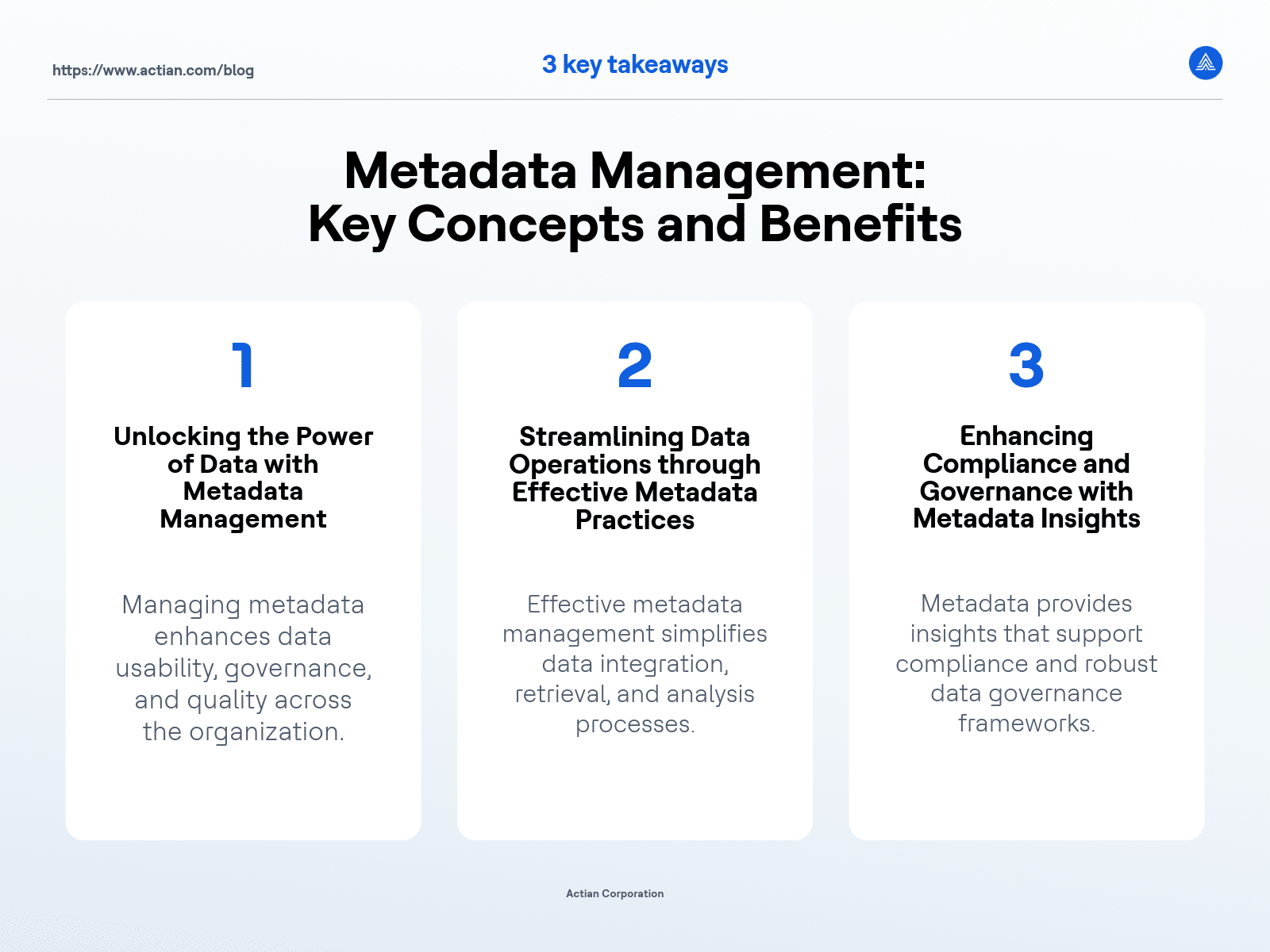Metadata is often described as “data about data,” but to fully grasp its significance, imagine it as a library catalog in a vast digital repository. In a traditional library, metadata includes details like book titles, authors, and publication dates, allowing visitors to locate books easily. In a business context, metadata encompasses various attributes that describe and categorize data assets, including information like file formats, source details, relationships, and usage statistics.
So, what is metadata management? Much in the same way that librarians organize books by titles, authors, etc., metadata management organizes data in an efficient way to improve analysis, distribution, and democratization — ensuring that it can be efficiently used by stakeholders in an organization. This guide will help businesses learn how to manage metadata effectively to improve efficiency and gain valuable insights.
How Does Metadata Management Work?
Metadata management involves several steps that collectively enhance an organization’s ability to find, govern, and utilize its data assets effectively. The management process generally begins with capturing metadata through automated discovery tools or manual input. Once captured, metadata is cataloged, stored, and organized in a metadata management tool — often a centralized repository called a metadata catalog or a data catalog.
The next step is classifying and standardizing metadata to ensure consistency across systems. This is crucial in organizations where multiple departments use different tools or databases. Metadata management tools provide automated features to enforce standard naming conventions, tags, and data classification rules.
The final stage is applying metadata governance and security protocols, where businesses set up access controls, compliance checks, and quality assurance workflows. Modern data management tools allow administrators to define rules for data access, usage, and lifecycle, ensuring the data remains compliant and reliable.
Types of Metadata
Metadata can be categorized into four main types, each serving distinct purposes in a data management strategy:
- Descriptive Metadata: This includes basic details that describe the content and characteristics of data, such as titles, author names, dates, and keywords. For example, the metadata of a customer record might include attributes like customer ID, name, and registration date. Descriptive metadata helps stakeholders quickly find and identify specific data assets.
- Structural Metadata: Structural metadata defines the relationships and organization within datasets. It is like a blueprint that describes how data elements relate to each other. For instance, it outlines the relationships between tables in a database or the hierarchy of folders in a file system.
- Administrative Metadata: This type encompasses technical details that aid in data management and access control. It includes data about file types, access permissions, data creation dates, and ownership information. Administrative metadata plays a key role in governing data and ensuring security.
- Operational Metadata: This refers to information generated during data processing, such as data lineage, logs, and transformation details. It offers insights into how data flows through an organization and tracks its changes over time.
These metadata types come from a variety of sources, including data ingestion tools, applications, user inputs, and automated processes. Together, they provide a holistic view of enterprise data, supporting critical activities such as data security privacy, governance, and regulatory compliance.
Managing Active vs. Passive Metadata
Active metadata involves dynamic, real-time information about data usage, processing, and changes. It is constantly updated to reflect the current state of the data. For example, active metadata tracks user activities, access patterns, and data flows within a system, which can help organizations identify inefficiencies or security risks.
Passive metadata, on the other hand, consists of static information captured at a single point in time. This includes basic descriptions, relationships, and technical attributes that do not change dynamically. Passive metadata might describe the structure of a dataset or the author and creation date of a document, but it does not automatically track how the data is being used or modified.
The distinction between active and passive metadata becomes significant when managing data across complex enterprise environments. Active metadata provides real-time insights into data usage and governance, while passive metadata forms the foundational information that helps users understand the structure and nature of data.
Benefits of Enterprise-Level Metadata Management
Effective metadata management at an enterprise level provides numerous advantages:
Enhanced Data Quality
By standardizing and organizing metadata, businesses can address inconsistencies and ensure that data is accurate and up to date. When asked, “How does metadata improve data quality?” the answer is simple: it provides a clear picture of data sources, transformations, and usage patterns, which helps identify and rectify data quality issues.
Improved Data Discovery and Accessibility
Metadata acts as a roadmap, guiding users to quickly find the data they need. Tools such as metadata catalogs index and categorize datasets, making it easier to search and navigate for specific information.
Regulatory Compliance
Metadata management supports compliance efforts by tracking data lineage and ensuring that data handling practices align with regulatory standards. It enables organizations to audit their data flows and prove adherence to data compliance regulations like GDPR or HIPAA.
Informed Decision-Making
With better-organized metadata, organizations gain more visibility into their data assets, empowering leaders to make data-driven decisions with confidence.
Streamlined Data Integration
Metadata management provides a standardized approach to managing data from various sources, ensuring seamless integration and data integration quality across the enterprise.
Metadata Management Best Practices
Managing metadata effectively requires a strategic approach. Here are some best practices for enterprise metadata management:
- Establish Clear Governance Policies: Define roles, responsibilities, and ownership for metadata management. Having a well-defined data governance policy ensures that everyone in the organization understands their role in maintaining metadata quality and security.
- Automate Metadata Discovery and Tagging: Leverage automated tools to discover, capture, and tag metadata from various sources. This minimizes manual errors and ensures metadata is updated in real-time.
- Maintain a Centralized Metadata Catalog: A unified catalog consolidates all metadata in a single repository, simplifying access and ensuring consistency across the organization.
- Implement Data Quality and Lineage Tracking: Regularly audit and monitor metadata to ensure that data remains accurate and that all changes are traceable. This helps maintain the integrity and reliability of metadata information.
- Invest in Scalable Metadata Management Solutions: As data volumes grow, scalable tools and data management platforms help businesses handle increasing complexity without compromising performance.
Metadata Management Software
Metadata management tools are pivotal in organizing and maintaining metadata at an enterprise level. These tools offer automated capabilities to catalog, classify, and analyze metadata across diverse data sources, streamlining the entire process. They provide features such as data discovery, lineage tracking, quality checks, and visualization of relationships between datasets.
For instance, Zeenea’s Data Platform stands out as a comprehensive solution for enterprise metadata management. As one of Actian’s software products, it allows businesses to catalog all their data assets and establish a single source of truth for their metadata. Zeenea provides robust capabilities for real-time metadata updates, automated tagging, and powerful search functionalities, helping organizations improve data accessibility and governance. Additionally, Zeenea’s scalable architecture enables enterprises to manage their growing metadata needs effectively, without losing control over data quality and compliance.
What is Metadata Management’s Impact on Big Data?
Metadata management is a crucial component of enterprise data strategies, ensuring that data remains organized, accessible, and reliable. By defining and managing metadata effectively, organizations can enhance data quality, improve discovery, streamline compliance, and drive better decision-making.
To institute effective metadata management programs, organizations must keep the following points in mind:
- Understanding the Role of Metadata: Metadata serves as the backbone of data organization, providing essential details about data assets.
- Differentiating Active and Passive Metadata: Both active and passive metadata play complementary roles in improving data visibility and governance.
- Implementing Best Practices: From governance policies to automated tools, successful metadata management requires strategic planning and execution.
- Using Comprehensive Tools Like Zeenea’s Data Platform: Investing in scalable metadata management solutions is critical to support growth and maintain data quality.
In an era where data is critical to business success, metadata management best practices and implementation are key. Metadata management is a crucial enabler that underpins data governance, compliance, and analytics efforts, driving organizations toward becoming more data-driven and agile.
Key Takeaways




